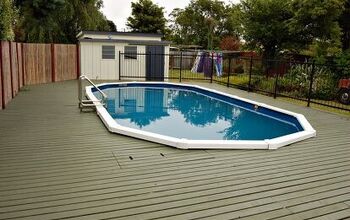What Is The Best Material For Pool Furniture?

Buying the right pool furniture is critical when you are trying to create the perfect vibe for your backyard oasis. A pool is a great way to create an elegant and tranquil atmosphere, but without the right furniture, a pool can look drab and shabby. So, when you are shopping for pool furniture, you want to make sure you buy something long-lasting and chic. But what is the best material for pool furniture?
Teak wood is perhaps the best material for pool furniture. It looks sleek and natural, and last decades, even when exposed to the elements. It is also quite expensive. Resin wicker is another popular, long-lasting, and more affordable option to teak, and there are many brands with great synthetic woven pool furniture. For those on tight budgets, consider well-made recycled plastic furniture, rattan, or aluminum.
There are endless directions you can go when selecting pool furniture. From futuristic designs and man-made fabrics to antique wood and cast iron statement pieces, the options are endless. But before you make an impulse purchase, there are several factors you should think about that can end up saving you money and hassle in the long run.
Factors To Consider When Shopping For Pool Furniture
1. The Climate
One of the most important variables you need to think about when considering pool furniture is your climate. The vast majority of pool furniture lives outside for half the year or is even left out through the winter. This means it needs to be able to survive your climate.
If you live in a dry hot climate, ensure you don’t buy material that warps or cracks in UV light and heat. If you live in a wet climate, make sure you consider mold and rust risks.
2. Comfort
You want your pool furniture to be comfortable. So, while it might be nice to buy wrought iron for its long-lasting abilities, it is not exactly the ideal material to dry off on after a luxurious dip.
3. Longevity
Unless you have an endless supply of money to spend, you want to buy pool furniture that lasts. When you choose pool furniture, you need to select materials that will stand the test of time.
4. Price
Just like with all purchases, price is a major deciding factor. As you will see in our list below, some of the best materials for pool furniture are also by far the most expensive. Do your best to find the highest quality within your personal budget.
5. Aesthetics
Make the area look great! Find pool furniture that combines fashion and function. After all, you want pool furniture that lasts a long time, so choose a material and design that you will enjoy looking at for all those years.
The Top Six Materials For Pool Furniture
1. Teak Wood
One of the most trusted materials for any outdoor furniture for more than one hundred years is teak wood. Teak is known for its density, which makes it strong and durable.
But more than this, teak is one of the few kinds of wood that naturally produces an oil that repels water. That’s right, this wood is naturally waterproof. This makes it resistant to warping, rot, and mold, and thus it has great longevity.
Teak is also very chic. The wood is a rich golden brown and can be stained to look several different shades.
- Drawbacks To Choosing Teak: While teak is arguably the best material for pool furniture, it is also one of the most expensive. There are more expensive woods than teak, but the price is high, especially for well-designed furniture.
2. Resin Wicker
Man-made woven pool furniture has exploded in popularity in the last 10 years or so. In fact, it’s hard to sit at a pool bar or a neighbor’s patio without spotting a piece of resin wicker. Resin wicker uses the same weaving techniques as wicker, but with durable man-made resin materials.
Resin wicker is great because its woven design takes a man-made material and breathes some style and class into it, making you forget it’s essentially a form of plastic. It is also very weatherproof, as well as affordable, with a great variety of designs and colors.
- Drawbacks To Resin Wicker: Just as there are a variety of designs, resin wicker also comes in a variety of quality levels. Many types of resin wicker can fray and break apart easily over time. The weaving might look strong, but it is sometimes not all that durable. Choose higher quality products with good reviews.
3. Aluminum
Another popular outdoor furniture material is aluminum. While metal outdoor furniture isn’t exactly comfortable to lay on directly, if you buy aluminum furniture and pair it with outdoor cushions, you can have a nice look.
Aluminum is both affordable and lightweight. It works well for those on a budget, as well as for those who like to move their pool furniture around.
Drawbacks To Aluminum: While lightweight material comes in handy sometimes, it is not suitable for extreme weather. You should think against aluminum if you live somewhere with high chances of extreme wind. Aluminum also requires regular cleaning.
4. Rattan
Another popular natural material for pool furniture is rattan. Rattan is a very popular style for patio and pool area furniture. The woven material is similar to wicker but often more durable. This is a great and more affordable option for those who want a natural look but can’t afford teak.
- Drawbacks To Rattan: Rattan doesn’t last nearly as long as durable woods like teak. Also, due to its woven nature, its grooves and nooks can be challenging to clean. This is a problem for those who live in dusty climates.
5. Coated Steel
Another option for pool furniture is steel. Just like aluminum, steel might not be ideal for reclining on, but combined with the right cushion, it can be a practical and even sleek material.
Steel, including stainless steel, is prone to rust. This is especially true when left outside in a pool area. Powder-coated steel is a great way to enjoy the strength and durability of steel without the concern of rust and decay.
Drawbacks To Coated Steel: While powder-coated steel is rust-proof, as soon as the coating is scratched or the material is cracked, it can rust. Also, when you buy hollow steel furniture, it is at risk of blowing in the wind.
6. Recycled Plastic
If money is tight but you are in need of quality furniture materials, consider well-made furniture made of recycled plastic. Recycled plastic is better for the environment than other plastics. It can also look quite stunning.
Plastic furniture has come a long way since the flimsy stackable plastic patio chair days of the 1950s. In fact, you can get innovative, well-designed, and even sleek futuristic plastic furniture for your pool area.
Plastic is easy to clean, and you never have to worry about rust or rot. It is also often quite affordable.
- Drawbacks To Plastic: While high-quality recycled plastics exist, there are also junky plastics out there, so be careful. Try and find a sweet spot between quality and price. Make sure you get furniture with UV protection, so it is not prone to cracks.
Final Thoughts On The Best Material For Pool Furniture
Picking the right material for your pool furniture is an important decision. You want to ensure you pick material that is long-lasting, good looking, and also practical.
Teak stands out as one of the best materials, as it is long-lasting, natural, and nice to look at. Resin wicker is a more affordable, and very popular option. Coated steel and aluminum work great as well, as long as you don’t live somewhere windy and can pair it with comfortable and stylish cushions. There are even great recycled plastic options at affordable prices.
Related Guides:

Tom Gaffey is an expert writer who currently resides in Washington D.C. Tom has a passion for real estate and home improvement writing, as well as travel and lifestyle writing. He lived the last twelve years in Hawaii where he worked closely with luxury resorts and event planners, mastering his knowledge of aesthetics and luxury products. This is where he found his passion for home improvement and a keen interest in DIY projects. Currently, Tom resides in Washington D.C, and also working on his debut fiction novel.
More by Tom Gaffey



























